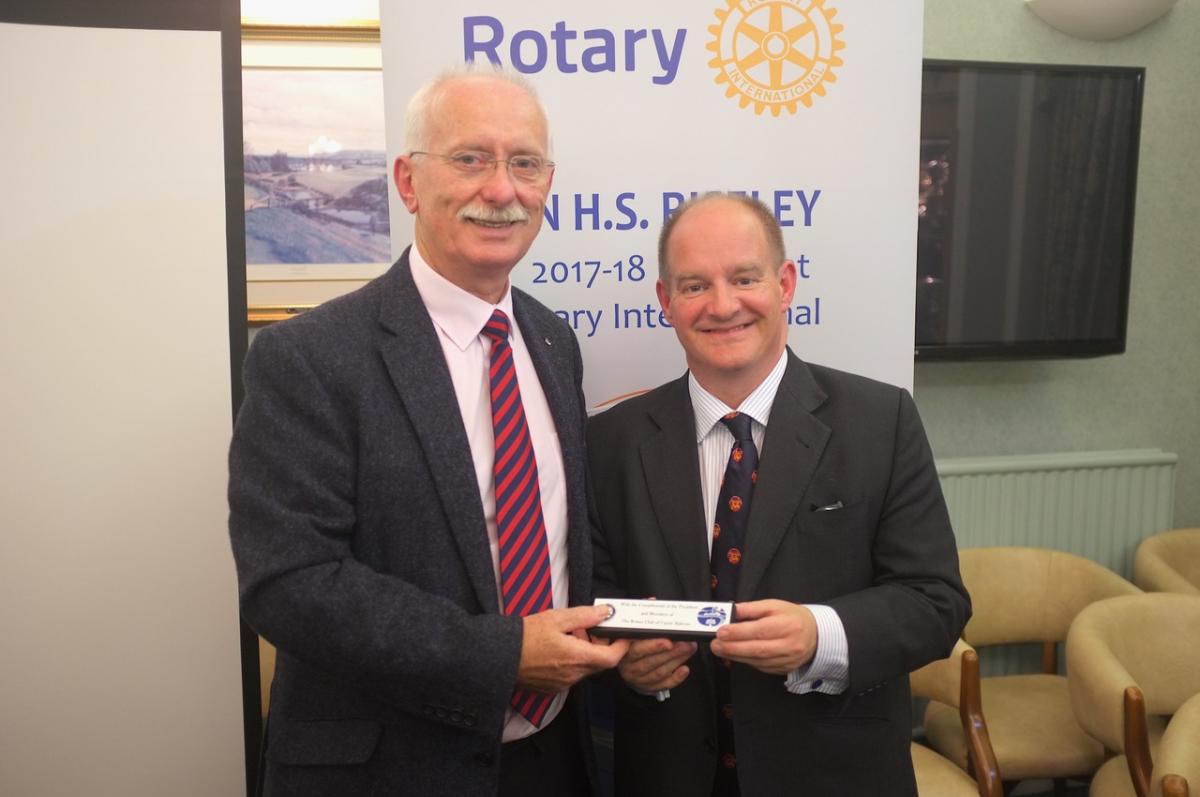Inside guide to questioning witnesses in court Professor David Parrat QC
Wed, Sep 6th 2017 at 7:00 pm - 8:30 pm
Professor David Parrat QC with President Graham

Members of the club were thoroughly entertained and gained an interesting insight to aspects the judiciary system by Professor David Parratt QC
David was called to the Bar in 1999 where he has developed a wide ranging practice covering many different aspects of civil law including land law construction, trust work, general commercial work and contract.
He has a keen interest in international commercial arbitration and has practical experience of various forms of alternative dispute resolution including arbitration, adjudication and mediation. He is a Fellow of the Chartered Institute of Arbitrators (FCIArb), holds Chartered Status and is a Board Member of the Faculty’s Dispute Resolution Service.
He called to the English Bar (Lincoln’s Inn) in 2009 and the Bar of Northern Ireland in 2016. Since 2012, he has held the position of Director of Training and Education at the Faculty of Advocates.
David started his talk by making comparisons with dramatisations that appear on television. In the television programme ‘Silk’, much of the programme is dramatized for entertainment purposes but much of it is also accurate. He cited ‘Crown Court’ as an early inspiration for his future career in law.
We were given a fascinating short history lesson on the Court of Session and Parliament House. The Court of Session itself was founded in 1532 and ratified by act in 1541. Parliament House was built in 1639 and replaced the Auld Tolbuyth next to St Giles. Advocates were certainly around in 1532 but no “Faculty” existed at that time. They were referred to as ‘men of law’ and had to be ‘cunning and wise’.
David then talked about Parliament Hall, built in 1639, using photographs and PowerPoint slides to provide a vivid description of the various parts of the building. The court was composed or an Inner House and Outer House. The Outer House was a preparatory court, preparing cases for judges in the Inner House. The Outer House was a bit chaotic and was open to the public who could do their shopping there! The Inner House is where the court sat. Initially they sat together in a semi-circle and were referred to as the ‘Haill Fifteen’. Parliament House developed other buildings to form the square we have today.
David then talked about the Advocates of today and where they fitted into the law profession. There are a number of branches in the profession, solicitors, solicitor-advocates and advocates. Advocates are specialists in the art of advocacy, the expert presentation of a case in court. They work independently but share a collegiality – “Argue hard like enemies in court but friends when you leave the confines of the court.”
David then went on to describe the long and challenging route to become an advocate. You have to meet the academic requirements, pass a number of Faculty Exams, matriculate as an Intrant to the Faculty and undertake a period of training known as the pupillage or “devilling”. This last 8 or 9 months and is spent with a “devil master”. Much of the work is learning on the job and taking time to sit in court and watch and learn.
David finished his talk by describing why being an Advocate is such a ‘rare’ job and providing a couple of very entertaining anecdotes to highlight the importance of knowing the language of your audience!
A generous vote of thanks to David was given on behalf of the club by Ian Greig.
Percy Farren
David was called to the Bar in 1999 where he has developed a wide ranging practice covering many different aspects of civil law including land law construction, trust work, general commercial work and contract.
He has a keen interest in international commercial arbitration and has practical experience of various forms of alternative dispute resolution including arbitration, adjudication and mediation. He is a Fellow of the Chartered Institute of Arbitrators (FCIArb), holds Chartered Status and is a Board Member of the Faculty’s Dispute Resolution Service.
He called to the English Bar (Lincoln’s Inn) in 2009 and the Bar of Northern Ireland in 2016. Since 2012, he has held the position of Director of Training and Education at the Faculty of Advocates.
David started his talk by making comparisons with dramatisations that appear on television. In the television programme ‘Silk’, much of the programme is dramatized for entertainment purposes but much of it is also accurate. He cited ‘Crown Court’ as an early inspiration for his future career in law.
We were given a fascinating short history lesson on the Court of Session and Parliament House. The Court of Session itself was founded in 1532 and ratified by act in 1541. Parliament House was built in 1639 and replaced the Auld Tolbuyth next to St Giles. Advocates were certainly around in 1532 but no “Faculty” existed at that time. They were referred to as ‘men of law’ and had to be ‘cunning and wise’.
David then talked about Parliament Hall, built in 1639, using photographs and PowerPoint slides to provide a vivid description of the various parts of the building. The court was composed or an Inner House and Outer House. The Outer House was a preparatory court, preparing cases for judges in the Inner House. The Outer House was a bit chaotic and was open to the public who could do their shopping there! The Inner House is where the court sat. Initially they sat together in a semi-circle and were referred to as the ‘Haill Fifteen’. Parliament House developed other buildings to form the square we have today.
David then talked about the Advocates of today and where they fitted into the law profession. There are a number of branches in the profession, solicitors, solicitor-advocates and advocates. Advocates are specialists in the art of advocacy, the expert presentation of a case in court. They work independently but share a collegiality – “Argue hard like enemies in court but friends when you leave the confines of the court.”
David then went on to describe the long and challenging route to become an advocate. You have to meet the academic requirements, pass a number of Faculty Exams, matriculate as an Intrant to the Faculty and undertake a period of training known as the pupillage or “devilling”. This last 8 or 9 months and is spent with a “devil master”. Much of the work is learning on the job and taking time to sit in court and watch and learn.
David finished his talk by describing why being an Advocate is such a ‘rare’ job and providing a couple of very entertaining anecdotes to highlight the importance of knowing the language of your audience!
A generous vote of thanks to David was given on behalf of the club by Ian Greig.
Percy Farren
'What We Do' Main Pages:
Serving the Communities of Ratho, Kirknewton, Balerno, Currie, Juniper Green, Baberton, Colinton and Wester Hailes
moreRead about our Club initiatives
moreRead about our Club and where we are....
moreThis page features recent submissions to the press about our Club. Please note that the press editors may have made changes to the copy used for final publication
more